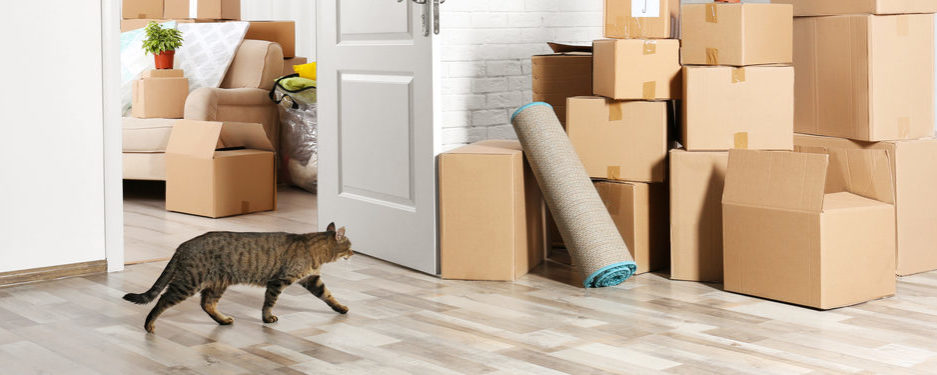Moving with pets raises human stress levels, and your cats and dogs are no different. While many dogs enjoy adventure and visiting new places (and smells!), cats identify closely with their home territory. And a move can put any pet’s tail in a twist when it disrupts their routine. An unfamiliar location, smells, and sounds raise levels of fear, anxiety, or stress (FAS).
With proper care, though, you can reduce or even eliminate the angst. Here are tips for moving with cats and dogs and helping them quickly acclimate to their new home.
Pack out of sight. Cats and dogs can become upset seeing furniture, clothes, and other familiar objects packed away. We know pets (especially cats) love boxes, so having them around your cat could risk your pet hiding away and getting lost. Confine pets to a safe room away from all the disruption until you finish packing and move all the boxes out of the home. Put a sign on the door “PETS INSIDE, KEEP CLOSED!” Confining pets to a room with their property also prepares them for their first few days in their new home, where they’ll also be temporarily confined.
Prepare for travel. Prepare pets ahead of time for car or airplane travel. For smaller pets, acclimating them to a safe carrier or crate helps enormously. The crate becomes the one constant and familiar-smelling safe spot for your pet both during travel and once you arrive at your new home. If you’re traveling by plane, check with the airline to be sure your crate meets their size criteria. Here are some tips for traveling in cars with your pets.
Crate-train pets. Start at least two weeks before the move and leave the crate out all the time so pets can come and go at will. Turn it into a favorite sleep spot with a comfy bed or blanket. Hide fun toys or treats in the crate (perhaps catnip for kitties) to associate positive things with the location. Adding a t-shirt that you’ve worn but not washed adds your comforting scent and can help reduce stress. Feeding favorite meals inside the carrier can help enormously. Adding a favorite treat your pet receives only when inside the crate can also accelerate acceptance. Try giving a natural milk-based supplement of Zylkene (alpha-casozepine) to help calm pets of any age. You can offer Zylkene during pre-move packing, during travel, and during the transition phase of the first days in your new home to help reduce stress. It can be used short- or long-term depending on the individual pet’s circumstances and level of fear, anxiety, and stress.
Confine pets. At your new home, set up one room specifically for your dog or cat. It should contain all his toys, bowls, bed, and other familiar items, with litter box and scratch object for your cat. You’ll be unpacking boxes and opening and shutting doors, and don’t need a door-dashing pet adding to your headache. Be sure to shut windows, too. For the first several weeks, you may want to crate your dog whenever you leave the new home, so he feels more secure and won’t indulge in destructive separation behaviors.
Keep familiar gear. Resist the temptation to buy new cat trees, dog beds, and toys until after your pet becomes settled in the new place. Stocking the room with objects that have a familiar smell can help keep pets calm. Having a room of their own also helps pets become familiar with the new place, one small space at a time.
Pet-proof your new home. Think about all the “whoops” areas that might accidentally hurt your pet. You’re still learning about the new place, too, so think about electrical wires, window blinds, or any place that could serve as a place to hide. Be sure to check the fenced yard for toxic plants or yard supplies, too.
Use pet gates. Gradually expand your pet’s territory in the new house. Cats in particular won’t be interested in doing anything else until they’ve explored the new place top to bottom to find hiding spots, perching places, and lookouts. Opening the door could mean your pet disappears somewhere you can’t find him. But you can use moveable pet gates to segregate the upstairs, for example, or expand pet territory down a hallway. Once animals feel comfortable with the expanded area, you can move or remove the pet gate and supervise as they explore their new space.
Continue routine. As much as possible, maintain your pets’ regular schedule. Feed at the same time and continue scheduled walks, play sessions, or other normal activities. It can take two or more weeks for cats to adjust to and accept a new routine and home, so be patient. Dogs may adjust over a few days, but some also take weeks or months.
Offer leashed walks. For dogs, a walk around the new neighborhood familiarizes them with their new sniffing area. Show them all the cool spots, and encourage them to have fun. A secure fenced yard offers peace of mind for you and extra benefits for your dog, but you’ll still want to supervise outings. Ensure your dog can’t dig under or leap over the fence.
Update identification. Be sure to update your new address on your pet’s microchip or other identification in case he manages to go astray in the new place. See about locating a Fear Free Certified veterinarian and transferring your pets’ records.
Different cats and dogs adjust to new places at different rates. With these tips, you’ll increase the odds your pets adjust well, and as quickly as possible, to their new home-sweet-home.
This article was reviewed/edited by board-certified veterinary behaviorist Dr. Kenneth Martin and/or veterinary technician specialist in behavior Debbie Martin, LVT.
Amy Shojai, CABC is a certified animal behavior consultant and award-winning author of more than 35 pet books, Amy speaks professionally, consults with the pet industry as a spokesperson, is a founder and former president of the Cat Writers’ Association.
Brought to you by









